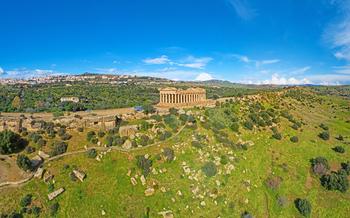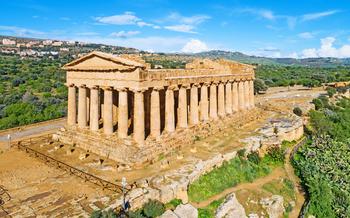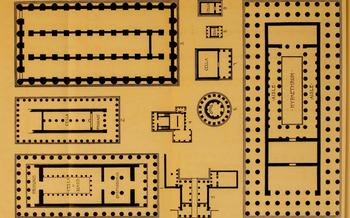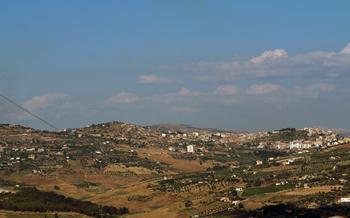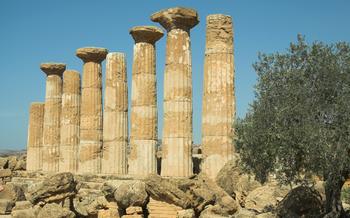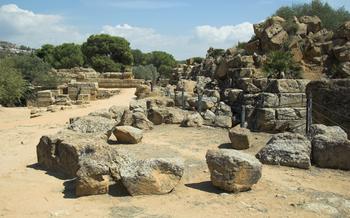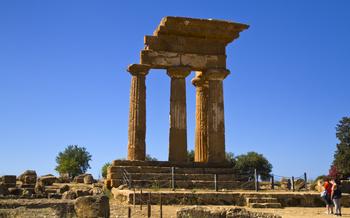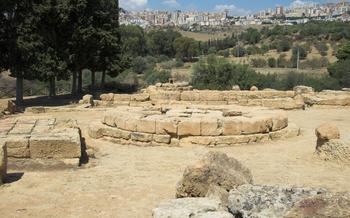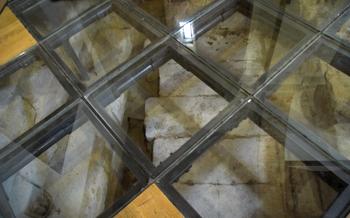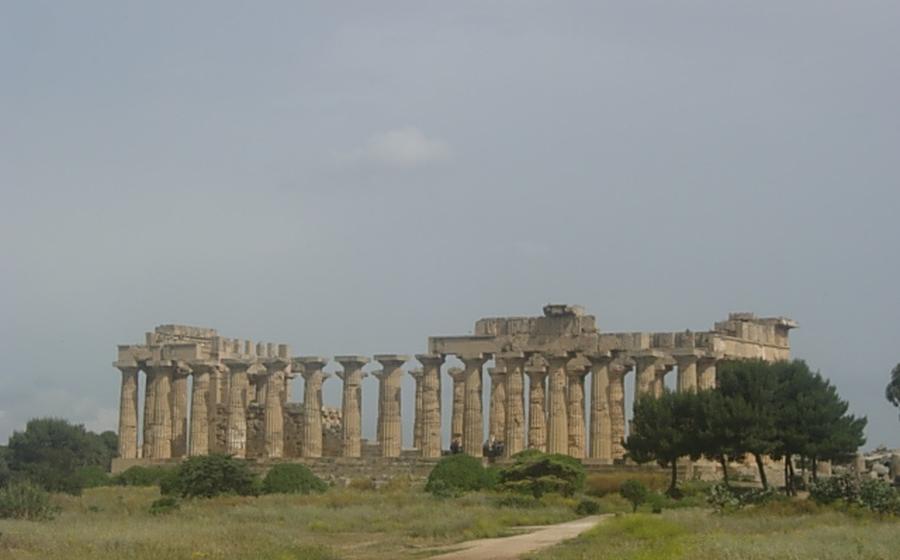
Agrigento Valley of the Temples
- Introduction
- Temple of Concordia
- Temple of Heracles: A Symbol of Strength and Grandeur
- Temple of Olympian Zeus: A Monumental Masterpiece
- Temple of Castor and Pollux
- Temple of Hephaestus
- Temple of Demeter and Persephone
- Archaeological Museum of Agrigento
- Visiting Tips
- Photography Tips
- Food and Drink
- Accommodations
- Insider Tip: Unveiling the Hidden Treasures of the Valley of the Temples
Introduction
In the heart of Sicily, on a majestic hilltop overlooking the Mediterranean Sea, lies the Valley of the Temples, an awe-inspiring archaeological site that transports visitors back in time to the golden age of ancient Greece. This sprawling expanse of ancient ruins and well-preserved temples is a testament to the architectural prowess and cultural significance of the ancient city of Akragas, once one of the most powerful and prosperous cities in the Mediterranean.
With its breathtaking scenery, fascinating history, and architectural wonders, the Valley of the Temples is a must-visit destination for anyone interested in ancient history, archaeology, or simply experiencing the beauty and grandeur of ancient Greek architecture. Prepare to be captivated as you wander among these monumental temples, each telling a unique story of a bygone era.
Temple of Concordia
Amidst the ancient ruins of the Valley of the Temples, the Temple of Concordia stands as a testament to the architectural prowess and religious devotion of the ancient Greeks. Remarkably preserved, this temple captivates visitors with its harmonious proportions, elegant Doric columns, and intricate sculptural decorations.
Dedicated to the Greek gods Concordia, the Roman equivalent of Venus, and Zeus, the king of the gods, the Temple of Concordia embodies the ideals of harmony, peace, and divine protection. Its construction dates back to the 5th century BC, during the golden age of Akragas, when the city flourished as a major power in the Mediterranean.
As visitors approach the temple, they are greeted by a majestic facade adorned with six massive Doric columns, each standing over 6 meters tall. The columns support a beautifully preserved entablature, featuring triglyphs and metopes, which once displayed intricate reliefs depicting scenes from Greek mythology.
Inside the temple, visitors can admire the well-preserved cella, or inner chamber, which once housed the cult statue of Concordia. The cella is surrounded by a colonnade of 13 Doric columns, creating an atmosphere of grandeur and solemnity.
The Temple of Concordia has undergone extensive restoration efforts over the centuries, ensuring its remarkable state of preservation. Today, it stands as a symbol of ancient Greek architecture and a testament to the enduring power of faith and devotion.
Temple of Heracles: A Symbol of Strength and Grandeur
Description and Architectural Features: The Temple of Heracles, also known as the Temple of Hercules, stands as a testament to the power and grandeur of ancient Akragas. This colossal structure, measuring approximately 100 meters in length and 50 meters in width, is the largest temple in the Valley of the Temples and one of the largest Doric temples in the world. Its impressive dimensions and well-preserved state make it a captivating sight for visitors. The temple features 38 massive Doric columns, each standing over 10 meters tall, creating a sense of awe and wonder. The temple's pediment, though now in ruins, once displayed intricate sculptures depicting the labors of Heracles, adding to its grandeur and mythological significance.
Significance and Dedication: The Temple of Heracles was dedicated to the Greek hero Heracles, known in Roman mythology as Hercules. Heracles was renowned for his extraordinary strength and his numerous legendary feats, including his twelve labors. His association with strength and courage made him a popular deity among the ancient Greeks, and the temple in Agrigento served as a place of worship and veneration for the hero. The temple's monumental size and impressive architecture reflected the importance of Heracles in the religious and cultural life of the city.
Challenges of Excavation and Restoration: Despite its size and prominence, the Temple of Heracles has faced significant challenges in terms of excavation and restoration. Unlike other temples in the Valley of the Temples, which have been extensively restored, the Temple of Heracles remains partially buried and in a state of ruin. Excavations at the site have been ongoing for over a century, revealing fragments of the temple's pediment and other architectural elements. However, due to its size and the complexity of the excavation process, the temple's full restoration remains a work in progress.
Temple of Olympian Zeus: A Monumental Masterpiece
At the heart of the Valley of the Temples, the Temple of Olympian Zeus stands as a testament to the grandeur and ambition of ancient Akragas. Dedicated to Zeus, the supreme deity of the Greek pantheon, this colossal temple was conceived on a scale that dwarfed its contemporaries. Its massive dimensions and impressive architectural features made it a symbol of the city's power and prosperity.
The temple's construction began around 480 BC, a period of great prosperity for Akragas. Designed by the renowned architect Phalaris, it was intended to be the largest Doric temple in the Greek world, surpassing even the Parthenon in Athens. Its ambitious design called for a colossal structure measuring approximately 113 meters in length and 56 meters in width, with a cella (inner chamber) that could accommodate a massive statue of Zeus.
Despite its ambitious beginnings, the Temple of Olympian Zeus was never completed. The reasons for its unfinished state are still debated, but historians suggest that a combination of factors, including financial constraints, political instability, and the outbreak of wars, may have contributed to its abandonment.
Today, the ruins of the Temple of Olympian Zeus stand as a testament to the grandeur of ancient Akragas. While only the platform and a few scattered columns remain, the sheer scale of the temple's foundation and the size of its unfinished drums (cylindrical sections of the columns) hint at the awe-inspiring structure that it could have been.
Despite its incomplete state, the Temple of Olympian Zeus remains a powerful symbol of the ambition and architectural prowess of the ancient Greeks. Its imposing presence and evocative atmosphere make it a must-visit destination for anyone interested in the history and culture of ancient Sicily.
Temple of Castor and Pollux
The Temple of Castor and Pollux is a smaller yet significant temple located in the Valley of the Temples. While not as grand in size as the Temple of Concordia or the Temple of Olympian Zeus, it holds its own unique charm and historical significance.
Constructed in the 5th century BC, the Temple of Castor and Pollux is dedicated to the twin gods Castor and Pollux, known in Greek mythology as the Dioscuri. These divine twins were revered for their heroic deeds, including their participation in the Trojan War and their role as protectors of sailors and travelers.
The temple's well-preserved Doric columns, numbering six on each side and thirteen on the front and back, showcase the architectural prowess of the ancient Greeks. Despite its smaller dimensions, the Temple of Castor and Pollux exudes an air of grandeur and harmony.
Ongoing archaeological research at the Temple of Castor and Pollux aims to uncover more information about its construction, history, and significance. Excavations have revealed fragments of sculptures and decorative elements, providing valuable insights into the temple's original appearance and the religious practices that took place within its walls.
Temple of Hephaestus
The Temple of Hephaestus, dedicated to the Greek god of metalworking and craftsmanship, stands as a testament to the artistry and skill of the ancient Greeks. Its smaller size compared to other temples in the valley does not diminish its architectural significance. The temple features Doric columns, a defining characteristic of Greek architecture, adding to its visual appeal and historical importance.
Excavating and restoring the Temple of Hephaestus presented unique challenges due to its partial state of preservation. Archaeologists and conservators have meticulously worked to uncover and restore the temple's remains, ensuring that its legacy continues to inspire and educate visitors from around the world.
Temple of Demeter and Persephone
On a separate hilltop, overlooking the other temples in the Valley, stands the Temple of Demeter and Persephone, dedicated to the Greek goddesses of agriculture and the underworld, respectively. This temple, although smaller in size, is remarkably well-preserved, with its Doric columns still intact and evoking a sense of ancient grandeur.
The Temple of Demeter and Persephone holds great significance in Greek mythology, as it represents the cycle of life and death. Demeter, the goddess of the harvest, and her daughter Persephone, who spends half the year in the underworld with her husband Hades, symbolize the changing seasons and the rebirth of nature.
Ongoing archaeological excavations at the temple aim to uncover more information about its construction and history. Recent discoveries have shed light on the temple's religious significance and its role in the ancient city of Akragas. Visitors can explore the excavation site and learn about the ongoing research that is helping to piece together the story of this sacred place.
Archaeological Museum of Agrigento
The Archaeological Museum of Agrigento is a treasure trove of ancient artifacts that shed light on the rich history and culture of the Valley of the Temples. Located just a short walk from the temples themselves, the museum houses a diverse collection of sculptures, pottery, and other objects that provide a glimpse into the daily lives, religious beliefs, and artistic traditions of the ancient Akragantines.
One of the highlights of the museum is the collection of sculptures, which includes masterpieces such as the Telamon of Akragas, a colossal figure that once adorned one of the temples. The museum also houses a remarkable collection of pottery, ranging from everyday household items to finely decorated vases and amphorae. These artifacts provide valuable insights into the trade and commerce that took place in ancient Akragas, as well as the artistic styles and influences that shaped the city's culture.
In addition to its permanent collection, the Archaeological Museum of Agrigento also hosts temporary exhibitions and educational programs throughout the year. These exhibitions often focus on specific aspects of the Valley of the Temples or ancient Greek culture, providing visitors with an opportunity to delve deeper into the history and significance of this remarkable site.
Whether you are a history buff, an art enthusiast, or simply curious about the ancient world, a visit to the Archaeological Museum of Agrigento is a must. The museum's collection offers a fascinating glimpse into the lives and culture of the people who inhabited the Valley of the Temples, bringing the ancient past to life in a vivid and engaging way.
Visiting Tips
Planning a visit to the Valley of the Temples requires careful consideration to make the most of your experience. Here are some practical tips to ensure a smooth and enjoyable visit:
-
Timing is Key: Aim to visit during the shoulder seasons (spring or fall) when the weather is pleasant, and tourist crowds are smaller. Consider arriving early in the morning or late in the afternoon to avoid the midday heat and enjoy the temples in a more tranquil atmosphere.
-
Dress Code: Respect the sacred nature of the site by dressing appropriately. Avoid shorts, tank tops, or revealing clothing, as it may be considered disrespectful. Comfortable walking shoes are essential as you'll be doing a lot of walking on uneven terrain.
-
Accessibility: The Valley of the Temples is partially accessible for visitors with disabilities. There are designated wheelchair-accessible paths and ramps. However, some areas, such as the steps leading to the temples, may be challenging to navigate.
-
Guided Tours: Enhance your visit by booking a guided tour. Knowledgeable guides can provide insights into the history, mythology, and architecture of the temples, bringing the ancient ruins to life. Audio guides are also available for self-guided exploration.
-
Combine and Conquer: Take advantage of the proximity to other attractions. Combine your visit to the Valley of the Temples with a trip to the Scala dei Turchi, a stunning white-sand beach just a short drive away. Or explore the historic town of Agrigento, known for its well-preserved medieval architecture and charming atmosphere.
Photography Tips
To capture the essence and beauty of the Valley of the Temples through photography, it's essential to consider the following tips:
-
Camera Settings: Opt for a wide-angle lens to capture the grandeur of the temples within their natural surroundings. Use a tripod to ensure stability, especially when shooting in low-light conditions. Adjust your shutter speed and aperture to achieve the desired depth of field and motion blur effects.
-
Lens Choice: A wide-angle lens, such as a 16-35mm or 24-70mm, will allow you to capture expansive shots of the temples and the surrounding landscape. A telephoto lens, such as a 70-200mm, can be useful for capturing close-up details and isolating architectural features.
-
Composition Techniques: Experiment with different angles and perspectives to create visually compelling images. Incorporate leading lines, such as the rows of columns, to draw the viewer's eye into the composition. Use the natural light to your advantage, shooting during the golden hours of sunrise and sunset to create warm and dramatic lighting conditions.
-
Viewpoints: The best viewpoints for photography in the Valley of the Temples include the Temple of Concordia, offering a panoramic vista of the entire valley. The Temple of Juno Lacinia provides a unique perspective of the temples set against the backdrop of the Mediterranean Sea. The Giardino della Kolymbethra, a botanical garden within the park, offers a tranquil setting for capturing close-up details of the temples amidst lush greenery.
-
Time of Day: The best time to visit the Valley of the Temples for photography is during the golden hours of sunrise and sunset. At these times, the soft, warm light casts a magical glow on the temples, creating stunning photographic opportunities. Avoid visiting during the harsh midday sun, as the intense light can create unflattering shadows and reduce the visibility of architectural details.
Food and Drink
When visiting the Valley of the Temples, be sure to indulge in the local culinary delights. In the vicinity of the temples, you will find an array of restaurants and cafes offering authentic Sicilian cuisine and panoramic views of the ancient ruins.
For a taste of traditional Sicilian flavors, try the pasta alla Norma, a dish of pasta topped with a rich tomato sauce, fried eggplant, and ricotta salata cheese. Arancini, deep-fried rice balls filled with various fillings such as meat ragu, mozzarella cheese, or vegetables, are another must-try. And for a sweet treat, don't miss the cannoli, crispy pastry shells filled with a sweet ricotta filling.
If you prefer a more relaxed dining experience, consider packing a picnic lunch and enjoying it amidst the ancient ruins. Designated picnic areas and spots are available within the park where you can spread out your blanket and savor your meal while surrounded by history.
Accommodations
When considering accommodations near the Valley of the Temples, there's a range of options to suit every taste and budget. For a truly immersive experience, opt for a stay at one of the charming guesthouses or bed and breakfasts nestled within walking distance of the temples. These cozy establishments offer a taste of Sicilian hospitality and provide a convenient base for exploring the ancient site.
For those seeking a more luxurious stay, there are several upscale hotels located just a short drive from the Valley of the Temples. These hotels offer panoramic views of the temples, world-class amenities, and easy access to the archaeological site. No matter your preference, booking your accommodations in advance is highly recommended, especially during the peak tourist season, to secure your desired room and avoid disappointment.
Insider Tip: Unveiling the Hidden Treasures of the Valley of the Temples
Beyond the iconic temples that grace the main archaeological site, the Valley of the Temples holds secret spots and hidden gems that offer a unique and unforgettable experience. Venture off the beaten path to discover the Temple of Asclepius, a sanctuary dedicated to the Greek god of healing. Nestled amidst lush greenery, its well-preserved ruins evoke a sense of tranquility and serenity. For a breathtaking panoramic view, climb to the top of the Rupe Atenea, a hill located within the park. From this vantage point, you can admire the temples and the surrounding countryside, capturing the essence of this ancient and majestic landscape.
To escape the crowds and immerse yourself in the tranquility of the Valley of the Temples, visit during the early morning or late afternoon hours. As the sun casts a golden glow across the ruins, you'll have the opportunity to experience the site's magic without the throngs of tourists. Embrace the solitude and connect with the spirit of this ancient place, where history and nature intertwine, creating a truly unforgettable experience.
